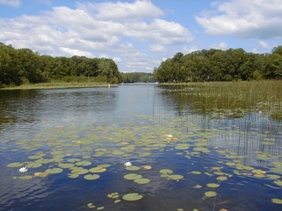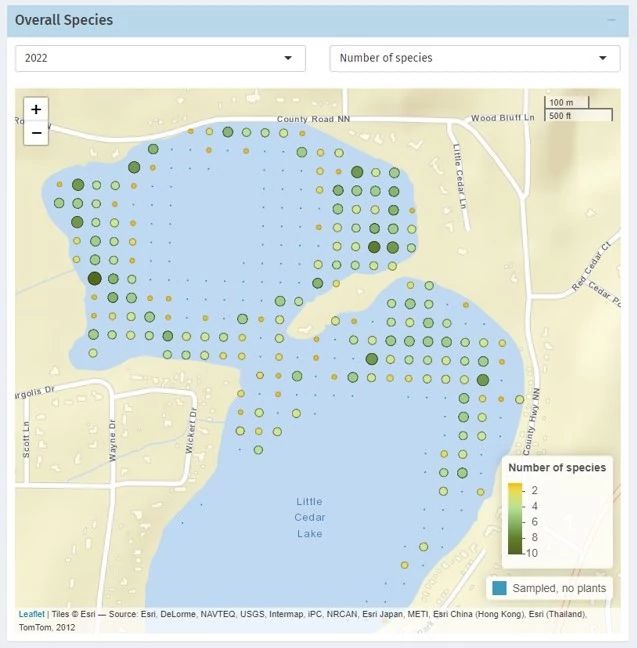Aquatic Plants
Aquatic plants form the foundation of healthy and flourishing lake ecosystems - both within lakes and rivers and on the shores around them. They not only protect water quality, but they also produce life-giving oxygen. Aquatic plants are a lake's own filtering system, helping to clarify the water by absorbing nutrients like phosphorus and nitrogen that could stimulate algal blooms. Plant beds stabilize soft lake and river bottoms and reduce shoreline erosion by reducing the effect of waves and current. Healthy native aquatic plant communities help prevent the establishment of invasive non-native plants like Eurasian water-milfoil, purple loosestrife or phragmites.

Healthy lake
It makes sense that the best fishing spots are typically near aquatic plant beds. Aquatic plants provide important reproductive, food, and cover habitat for fish, invertebrates and wildlife. It's aquatic plants that fashion a nursery for all sorts of creatures ranging from birds to beaver to bass to bugs. In order to maintain healthy lakes and rivers, we must maintain healthy native aquatic plant communities.
In most instances, control of native aquatic plants is discouraged or should be limited to high use recreational areas that are next to piers and docks or within navigational channels. In some cases there may be penalties for improper removal of aquatic plants.
Aquatic Plant Explorer

The Aquatic Plant Explorer (APEx) displays aquatic plant data from lakes, reservoirs and flowages across Wisconsin. View statewide distributions of aquatic plant species and individual lake maps that display plant abundance, the number of species, and the distribution of each aquatic plant species. APEx also graphs changes in abundance of particular plants over time and evaluates the overall condition of aquatic plants in the lake.
Aquatic Plant Management
In order to protect diverse and stable communities of native aquatic plants and prevent the spread of invasive aquatic plants, many aquatic plant management and nuisance control activities require a permit issued by the DNR. Please contact your local aquatic plant management coordinator before engaging in any aquatic plant management or nuisance control activities.
Permits are needed for aquatic plant control when:
- chemicals are used (NR 107, Wis. Adm. Code, WPDES);
- biological controls are used (NR 107, Wis. Adm. Code);
- physical techniques (e.g., drawdown or bottom plant barrier) are used (Ch. 30/31);
- wild rice is involved;
- plants are removed mechanically (NR 109, Wis. Adm. Code); or
- plants are removed manually from an area greater than 30 feet in width along the shore (NR 109, Wis. Adm. Code)
Additionally, it is illegal to transport boats or boating equipment that has aquatic plants or zebra mussels attached. Introductions of aquatic plants for planting require a permit.
There are many different ways to manage aquatic plants in Wisconsin, ranging from hand-pulling plants through large-scale harvesting or herbicide treatments. The best management strategy will be different for each lake. It depends on which nuisance species need to be controlled and how widespread the problem is and the other plants and wildlife in the lake. Even things like what activities occur on the lake and upstream in the watershed might affect your strategy. Keep in mind that each lake's management plan may also change over time. It is important to have a conversation with your local aquatic plant management coordinator if you are considering management of aquatic plants on your lake. You can also find some helpful resources through the following resources.
- UW-Extension: Aquatic Plant Management Guide
- University of Florida: Center for Aquatic and Invasive Plants
- Aquatic Ecosystem Restoration Foundation: Biology and Control of Aquatic Plants - A Best Management Practices Handbook
The DNR conducted a strategic analysis of aquatic plant management in Wisconsin to inform future discussions and decision-making (under Chapter NR 150.10, Wis. Adm. Code). Visit the strategic analysis webpage for more information.
Aquatic Plant Protection
Aquatic plant protection begins with us. We need to work to maintain good water quality and healthy native aquatic plant communities. How can we do it? The first step is to limit the amount of nutrients and sediment that enter the lake. There are other important ways to safeguard a lake's native aquatic plant community. They may include developing motor boat ordinances that prevent the destruction of native plant beds, limiting aquatic plant removal activities, designating certain plant beds as Critical Habitat sites and preventing the spread of invasive plants, such as Eurasian water-milfoil.
If plant management is needed, it is usually in lakes that humans have significantly altered. If we discover how to live on lakes in harmony with natural environments and how to use aquatic plant management techniques that blend with natural processes rather than resist them, the forecast for healthy lake ecosystems looks bright.
Additional Resources
- APM Permit Search Instructions
- Apply for an Aquatic Plant Management Permit Online
- WPDES Pollutant Permit Information
- Monitoring Protocols and Worksheets
- Pesticide Warning Sign - Fillable Form, English
- Pesticide Warning Sign - Non-Fillable Form, English [DOCX]
- Pesticide Warning Sign - Non-Fillable Form, Hmong [DOC]
